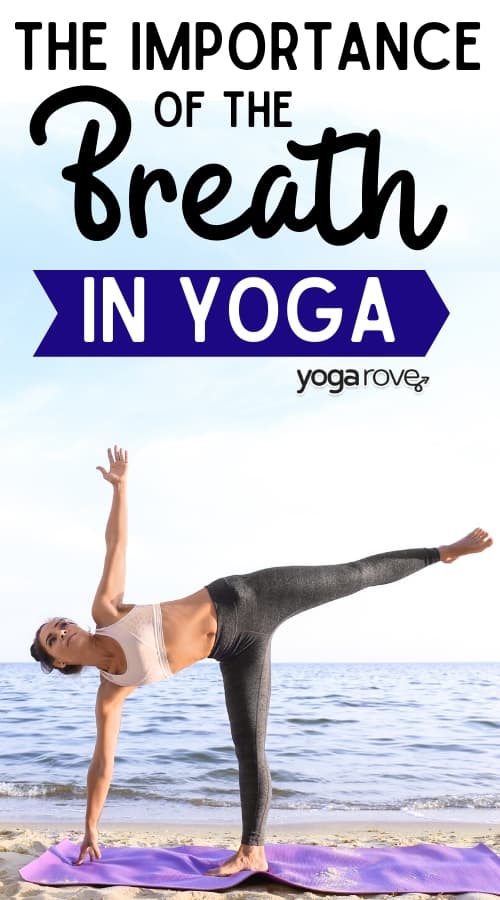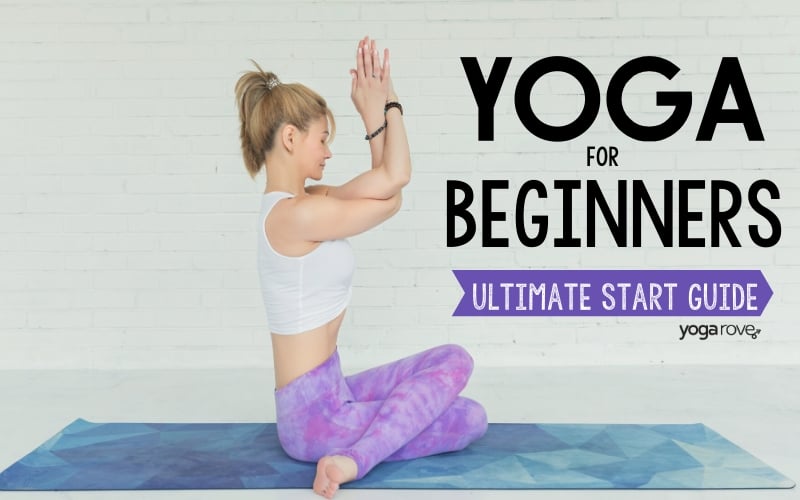This post may contain affiliate links. Please read our disclosure for more info.
The breath- it’s the only thing that’s with you from the moment you’re born to the moment you pass.
Seriously – when you think about it that way, the breath is pretty powerful stuff!
Why is breathing important in yoga? Breathing unites the body and mind together, and can change the way you feel mentally, emotionally, and physically –it also aids your body’s physiological processes.

Breath is what makes yoga, yoga! Yoga translates to “union” or “yoke” in English – it’s the union (or yoking) of breath, body, and mind. In fact, the “original” yoga centuries ago were only breathing and meditation; there was no physical asana practice at all!
Asana (yoga poses) first came to be solely as a method to achieve optimal breathing, and there were only about 10 of them, so yeah… you can say breathing is pretty important to yoga… but why?
Why You Should Practice Breathing Techniques in Yoga
There are so many benefits of integrating the breath into yoga and your daily life. Here are a few good reasons why you may want to pay a little extra attention to your breath in your practice:
1. Decreased physiological stress
Deep breathing increases activity of the vagus nerve, which is a main component of the parasympathetic nervous system (the calming, non-stressed system).
The vagus nerve controls and measures the activity of many internal organs, and when stimulated, allows a state of calm to pervade the entire body via muscle relaxation, blood pressure decrease, and more. As these physiological changes occur, the vagus nerve also sends signals to the brain that it, too, can relax. When your physiological body is relaxed, your mental body is at peace, too– and everything works better.
2. Improved circulation, blood flow, and organ function
Taking in more oxygen means the heart and vital organs can function more efficiently; improving overall circulation.
Nearly every system in the body requires oxygen to function optimally (you can only last about 10 minutes without oxygen until your brain begins to atrophy); it goes into building the cells that make up the body, helps the body defend itself against viruses and bacteria, and keeps the blood flowing optimally.
3. Improved focus, presence, and mental clarity
When you’re focusing on your inhales and exhales properly, you literally are thinking of nothing else– in doing so, you’re in the here and now, fully present.
Additionally, when you practice deep breathing, you are able to “see” thoughts, observe them, and let them go as needed– opening yourself up to a space of non-judgement of whatever thoughts and emotions present themselves. In doing so, you’ll find that you’re more in tune with what’s going on mentally and emotionally, and can therefore act from a space of clarity and peace, rather than confusion and stress.
4. Decreased mental and emotional stress; increased happiness
Stress and fear trigger your sympathetic nervous system to release stress hormones (adrenaline and cortisol) that kick up the fight-or-flight response. By breathing deeply, you call on the parasympathetic system to turn off those hormones.
Note: It doesn’t take huge stressors to build up stress that’s detrimental to your body– everyday things like bills, traffic, assignments, etc. compound every single day, especially if and when they’re not addressed and released.
Also note: Your breath can literally change your emotions – have you heard of that study where unhappy people are forced to smile, and their brains are activated as feeling happy? Breath is the same way, whereby increasing it = decreasing stress and increasing happiness.
5. Injury prevention
Think of drunk driving accidents; the drunk person almost always sustains less injury than the sober person, because the drunk person’s body is relaxed, not tensed up. Our muscles tense up as a response to fear as a measure to protect us, but so often this actually hurts us.
When you breathe deeply, you signal to your body that you’re in a safe space, so the muscles can unclench, which will make releasing into postures and poses safer.
To apply: in any stretch, take a deep inhale, and on every exhale, allow your body to release deeper into it. Also– always remember to exhale on your twists (super important for protecting the spine!).
6. Detoxification
When we take shallow breaths, we’re not ridding our body of as much carbon dioxide as possible– so the other organs must take on the burden of metabolizing it, unduly stressing those organs (those long inhales of oxygen aren’t so beneficial if we don’t exhale all the carbon dioxide that the body produces as a result of breaking the oxygen down!).
8. Decreased/elimination of energy blockages
Breath is what moves prana, the life force energy, through the body (in Chinese medicine, it’s known as qi). This prana moves through 72,000 pathways, called nadis, in the body– and if this sounds a little “woo-woo,” read this article on researcher’s recent evidence that supports these channels’ existence.
There are 3 main nadis through which your prana moves through:
- Ida: dominates the left side of body; it’s feminine, cooling, and is associate with the moon
- Pingala: dominates the right side of the body; it’s masculine, heating
- Sushumna: begins at the base of your spine and extends up to the crown of the head; it represents balance.
It is through pranayama (breathing) that the Ida and Pingala channels are balanced, bringing equilibrium to and through the Sushumna. Throughout the day, when we’re subconsciously breathing, the left and right nostril alternate as to which one is dominant – and when they “swap” dominance, the Sushumna is activated (but only briefly); conscious breathing and pranayama techniques activate the Sushumna for longer periods, bringing more balance to the body.
Note: prana is not the breath– but breath is a predominant method of moving the prana through the body. Prana is also taken in (and released) through food consumption and digestion, energetic exchanges with the environment (such as being in nature and grounding), and energetic exchanges with other people (such as everyday conversations).
Types of Yoga Breathing Techniques
Pranayama (yogic breathing) focuses on 3 stages of respiration: inhalation, retention, and exhalation.
The following techniques will vary in how each stage is expressed, but will also include the 3 stages. The following 5 pranayama techniques vary in their benefits:
1. Simple Awareness
This requires zero breath manipulation on your part. Simply observe your body inhale and exhale.
How to:
- Observe if your inhales are longer than your exhales, or if your exhales are longer than your inhales – or if they’re even.
- Observe if you’re taking shallow, short breaths, or quality, long breaths.
- Practice for 3-5 minutes (we recommend setting a timer, so you’re not constantly checking the clock).
2. Ujjayi
This is one that you probably hear a lot in yoga class; it’s referred to as the ocean breath. It’s the way you’re, in the Vinyasa tradition of yoga, supposed to be breathing through every asana posture.
How to:
- Take a deep inhale through the nose, and then slightly constrict the back of the throat.
- Open your mouth to exhale and do so as if you’re trying to fog up a mirror in front of you (making a kind of silent “HA” in the back of your mouth).
- Once you’ve got the constriction down, close the mouth and complete all inhales and exhales out of the nostrils. Inhales and exhales should be the same length.
3. Alternate-Nostril Breathing
This technique builds on the pranayama principles of balancing the Ida and Pingala nadis to achieve balance and harmony in the body. It’s best for cooling down and relaxing, either to start off a meditation or wind down from physical practice.
How to:
- In a comfortable seated position, bring your right hand to a fist in front of your face, and extend the thumb and the ring finger (often, instructors will advise to extend the pinkie finger – that’s fine, too, but it’s not the traditional way).
- Gently close your right nostril with your thumb. Inhale through your left nostril, then close it with your ring finger.
- Open your right nostril and exhale slowly through it.
- Inhale through the right nostril then close it. Open your left nostril and exhale slowly through it.
- Repeat the full cycle 3-5 times, ensuring each inhale and exhale is of the same length (counting is a great way to do this – count as high as you can to achieve optimal results in the form of increased breathing).
4. Breath Retention (Kumbhaka)
This is also a cooling breathing practice good for starting meditation or cooling down after a flow. Beginners may need to start at counts of 5-8 rather than 10 counts and work up to 10 counts or higher. By holding your breath for short bursts of time, your lungs actually expand, allowing you to breathe in just a bit more, which sends more oxygen throughout your body.
How to:
- Inhale for a count of 10; hold at the top for a count of 10; inhale just a bit more and hold for 3-5 more seconds (or longer, if you can)
- Exhale slowly for a full count of 10.
- You can also try holding for 3-5 seconds after your 10-count exhale.
5. Breath of Fire (Kapalabhati)
This is an energizing breath that is not recommended if you are experiencing stress or anxiety, but is recommended when you need to wake up (like…instead of a cup of coffee ?).
It’s called breath of fire because it builds heat in the body, so it’s an excellent way to jumpstart your Vinyasa practice, too.
Note: It’s also referred to as skull shining breath, as it’s originally a kriya (cleansing) practice that was used to clarify/clear the mind (skull).
How to:
- Take a deep inhalation, then exhale slowly to prepare.
- Take another deep inhale, and using your lower abdominals, exhale in tiny, short bursts, so that your inhalation between each active exhalation is completely passive, keeping all inhales and exhales through the nostirls (not the mouth).
- Complete for 30-60 exhalations. Then take another deep inhale and exhalation. Repeated 2-3 times if desired.
A helpful visual: Have you ever used a dropper in a solution? Think of how squeezing the dropper releases what’s out of it, and without any active effort, liquid is sucked back into it when the squeeze is released. That’s kind of how this works, but with your breath. If this is making no sense, watch this video.
Breathing: it’s more than just yoga.
These breathing techniques are not limited to your yoga practice– the more you apply them throughout everyday of your life, the less stressed both your brain and your body will be.
Breathing techniques are excellent for calming anxiety (before your final exam or a big presentation to your coworkers), alleviating stress (after a long day), sleeping better, and just generally re-centering yourself when you feel out of sorts. Fire-building breathing, of course, is also excellent for waking up when you need it.
In fact, many therapists recommend the 365 method for reducing physical and mental stress:
At least 3 times a day, breathe at a rhythm of 6 cycles per minute (that’s a 5-second inhale and 5-second exhale), for 5 minutes – everyday (365 days a year).
A normal adult resting respiratory rate is 10-20 breaths per minute, while the average optimal resting respiratory rate according to medical textbooks is 12 breaths per minute (fun fact: older medical textbooks had it even lower, at 8-10 breaths per minute!)– practicing these breaths will get you down to a lower respiratory rate, which will improve your physical and mental health for years to come.
Previously a dancer, Ashley has been practicing yoga for over 15 years and teaching for 5.
She balances an executive-level “corporate” position during the day with healthy, mindful wellness practices in her free time to stay grounded; she lives on celery juice and cold brew, and can’t live without her dark chocolate!







At last a simple and clear understanding of not only how to breath in practice but how important it is. A great and helpful article.
So glad you enjoyed it Rae!
very nice Ally. Clear simple and pretty comprehensive. I can use some of the points to explain pranayama to beginner students!!
So glad you found it helpful Annalisa!